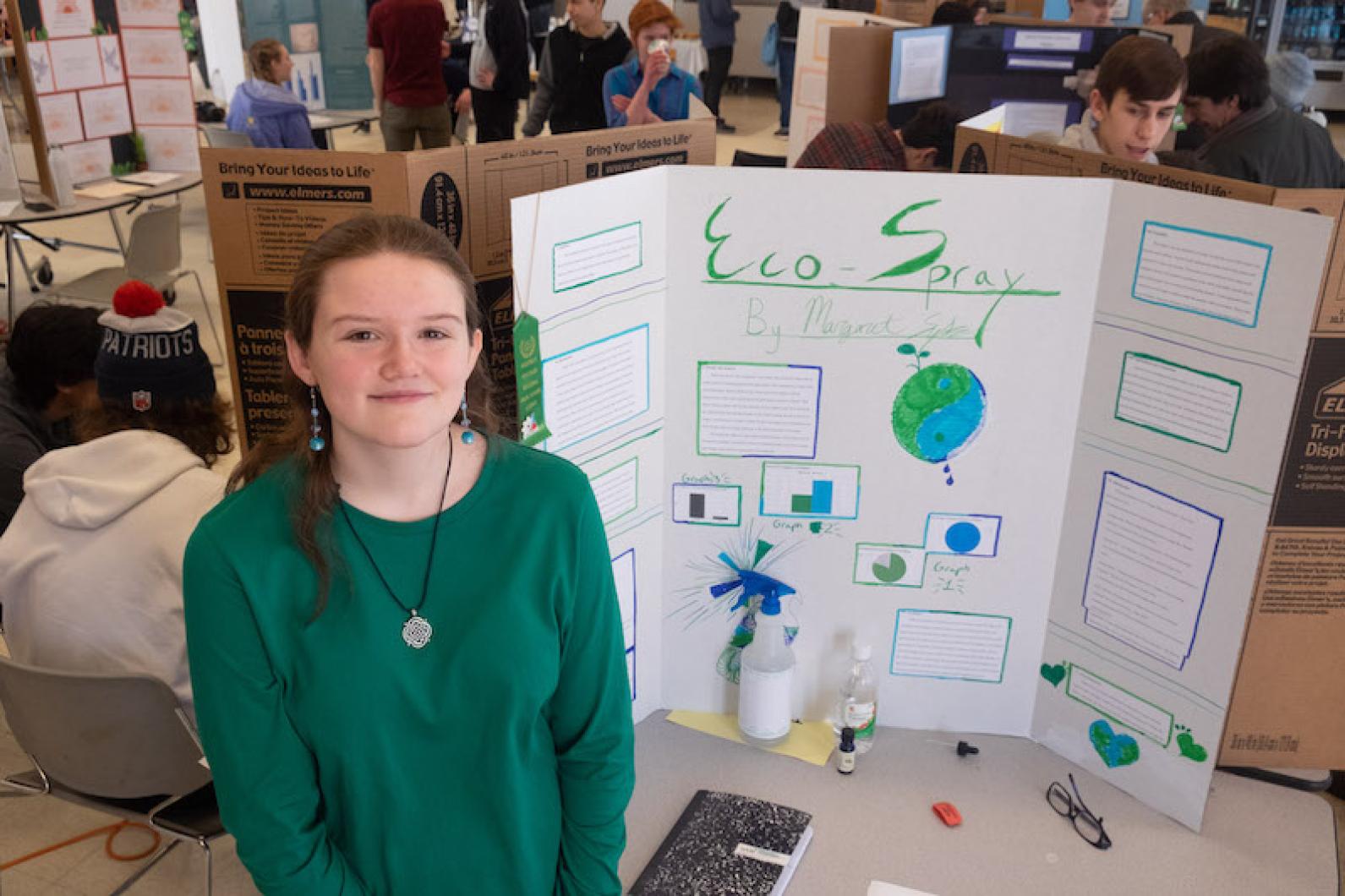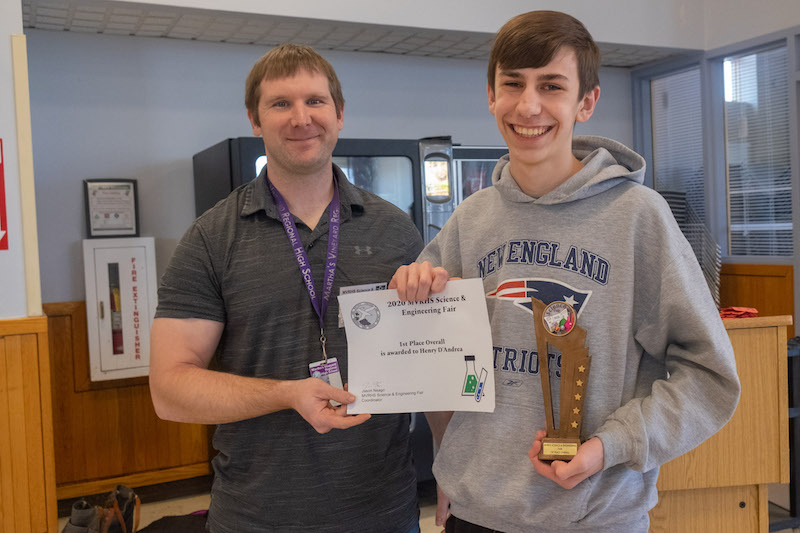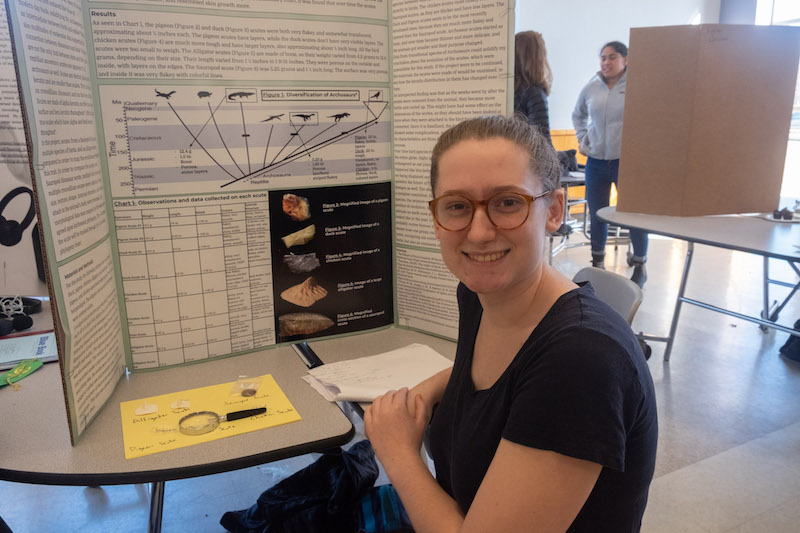Questions spanning from the Mesozoic era to the Space Age were answered by regional high school students at the 21st annual high school science fair on Saturday, with both local and far reaching conclusions. For example, what Island beach sand has the lowest melting point?
Answer: Lambert’s Cove.
“It’s a great opportunity for kids to explore their interest and work on a project that is meaningful to them,” said science teacher Jason Neago, who helped organize the fair. “It has become quite the tradition.”
One of the many students to stand out at the fair was junior Owen Steenkamp, stationed in front of a self-sustaining, solar powered hydroponics system that he designed and built himself using PVC piping, a small pump, plywood and K-cups re-purposed as flower pots. The pots featured a healthy crop of chard, arugula, chives and lettuce.
Growing up in South Africa in an area he described as arid and lacking in farm-able terrain, the project took on a special meaning to him. Owen said he wanted to create a system that was both sustainable and could maximize production in a small space.
“It took a while to build, but the concept is very simple,” he said. “It’s hard to farm for anything in South Africa. There is some traditional agriculture, but stuff like this could be huge there.”
Owen said he plans to study botany in college and is currently working on simplifying his hydroponics system so that it can be sent as a kit to families and farmers in South Africa. He received an engineering project honorable mention and the Island Grown Initiative award.
Junior Anne Culbert took her investigative project back to the time of dinosaurs. She compared the scutes (bony plates) of a Sauropod (purchased online from an Egyptian paleontologist) to those of an alligator (bought on Ebay) and a chicken (on lend from Gus Ben David) to learn how the evolutionary histories are linked.
“I’ve always been interested in dinosaurs,” she said. “The animals we see today are by no mean the end product of evolution.”
Anne won an honorable mention for her investigative project.
The overall winner of the fair was Henry D’Andrea for his project, Powering Sails in Space, which also won a first place prize in the engineering and physics divisions. Solar sails are massive reflective sheets that harness the energy of the sun and are capable of providing thrust to a spaceship when angled towards the sun.
“It’s theoretical, I don’t have a space ship in my backyard, but the math is real,” Henry said.
Henry cited Star Wars and the high cost of space travel as inspirations. His science project, he said, could make space travel more accessible to people in the future.
“I promise, it’s not that much rocket science,” he added.
Complete results follow:
Top Prizes
Overall Science and Engineering Fair Winner: Henry D’Andrea - Powering Sails in Space
1st Place Investigative Project: Annabelle Brothers - The Affects of Ocean Acidity on Scallops
1st Place Engineering Project: Henry D’Andrea - Powering Sails in Space
2nd Place Investigative Project: Peter Burke - Testing Martha’s Vineyard Deer Ticks for Lyme Infection
2nd Place Engineering Project: Owen Amodio - Refined Biodiesel Blend
3rd Place Investigative Project: Jack Crawford - Measuring Music Volume Levels Through Different Listening Devices
3rd Place Engineering Project: Ethan Creato and Eric Reubens - Can We Build a Self-Sufficient Biosphere?
Honorable Mention, Investigative
Anne Culbert - Comparative Morphological Analysis of Archosaur Scutes
Linus Munn and Jack Hayden - How Copper Leaches into the Water
Spencer Pogue - The Effects of Caffeine on Motor Function in Caenorhabditis elegans
Vivian Peak - Sand to Glass
Honorable Mention, Engineering
Delilah Hammerlund - Making Non-toxic, Natural, Smooth Paint
Kristin Perzanowski and Ingrid Moore - Biodegradable Shampoo
Owen Steenkamp - Designing and Building a Self Sustaining, Self Regulated, Solar Powered Hydroponics System
Henry Kyburg-Abbott and Liam Dawley - Direct Current Electric Motor
Special Awards
Sheriff’s Meadow Foundation Award: Peter Burke - Testing Martha’s Vineyard Deer Ticks for Lyme Infection
The David Brand Award: Ethan Creato and Eric Reubens - Can We Build a Self-Sufficient Biosphere?
The Island Grown Initiative Award: Owen Steenkamp - Designing and Building a Self Sustaining, Self Regulated, Solar Powered Hydroponics System
The Marine and Paleobiological Research Institute Award: Anne Culbert - Comparative Morphological Analysis of Archosaur Scutes
Martha’s Vineyard Surfcasters Association Award: Ben Yancey - The Affects of Nano Silver on the Environment
Sustainability Award: Owen Amodio - Refined Biodiesel Blend
Lagoon Pond Association Award: Annabelle Brothers - The Affects of Ocean Acidity on Scallops
Biology Award: Ethan Creato and Eric Reubens- Can We Build a Self-Sufficient Biosphere?
Physics Award: Henry D’Andrea - Powering Sails in Space
Chemistry Award: Spencer Pogue - The Effects of Caffeine on Motor Function in Caenorhabditis elegans
Technology Award: Owen Steenkamp - Designing and Building a Self Sustaining, Self Regulated, Solar Powered Hydroponics System









Comments
Comment policy »